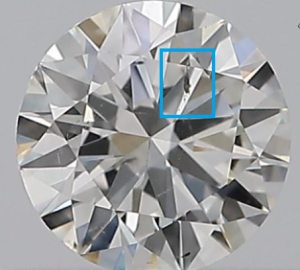The universe of gemstones is vast, each captivating with its intrinsic beauty. Among all gemstones, diamonds hold a special place due to their allure and rarity. Within every diamond hides an array of microscopic characteristics known as inclusions. These elements, perceived as blemishes by some, actually contribute to the stone’s unique identity and offer insights into its formation journey. Inclusions manifest in various forms, and one of the most intriguing types is the Twinning Wisp.

Twinning Wisp: A Unique Diamond Inclusion
In essence, a Twinning Wisp is not a single type of inclusion, but a series of inclusions that are interconnected. They occur as a result of the diamond’s growth process. During formation, diamonds may develop in different directions, leading to various forms of irregularity. This growth irregularity is the core reason behind the appearance of Twinning Wisps.
The term “Twinning Wisp” originates from the phenomenon known as “twinning,” which is a process where two separate diamond crystals grow together. These twinned crystals are not always perfectly aligned, leading to strain lines that form a distinctive pattern within the diamond. When the lines of these twinned crystals are filled with pinpoint inclusions or tiny fractures, the resulting structure is what we refer to as a Twinning Wisp.
The Influence of Twinning Wisps on Diamond Clarity
How Twinning Wisps influence a diamond’s clarity grading depends on their visibility, size, and location. When located centrally or large in size, they can affect the clarity grade significantly. Conversely, if they are small or located near the periphery of the diamond, they might have a lesser impact.
However, it’s essential to note that Twinning Wisps can add an interesting dimension to a diamond. They are, in a way, nature’s fingerprints on these precious stones. Like every diamond, each Twinning Wisp is unique, which can instill a sense of individuality and story to the stone.
Twinning Wisp’s Impact on Diamond Value
The presence of Twinning Wisps, like any other inclusions, can affect the value of a diamond. Yet, it is important to consider the degree to which these inclusions impact the stone’s overall appearance. Wisps that are minimal and barely noticeable even under 10x magnification will likely have little to no effect on the value.
However, prominent Twinning Wisps that impact the diamond’s transparency or brilliance can detract from its value. Moreover, if these inclusions make the diamond susceptible to damage (like cracking), this can also depreciate the stone’s worth.
Embracing the Individuality of Twinning Wisps
Twinning Wisps, a fascinating form of diamond inclusion, reveal the extraordinary journey that diamonds embark on as they form over billions of years. While these inclusions might affect the stone’s clarity and overall value, they also bestow upon each diamond a unique character and tale of its creation.
Whether you view Twinning Wisps as a disadvantage or appreciate them for adding a touch of individuality to the stone, understanding them helps us recognize the complex processes that create these captivating gems. Ultimately, the beauty of a diamond, like any piece of art, lies in the eye of the beholder.